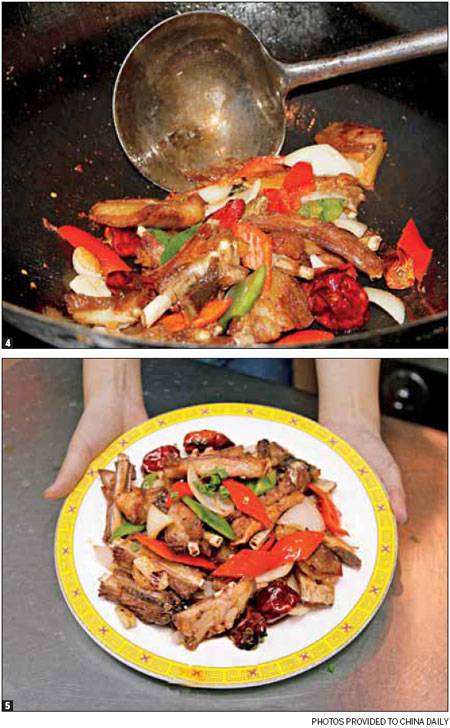Mouthwatering treat
Updated: 2013-12-20 10:07
By Liu Jue (刘珏) (China Daily Europe)
|
|||||||||||
Spice up your life with Tibetan fried mutton 让藏式羊肉温暖你的胃
As the saying goes: "A mutton meal in winter is more nourishing than ginseng; eat it in all seasons and it will strengthen your body. (冬吃羊肉赛人参,春夏秋食亦强身。 Dōng chī yángròu sài rénshēn, chūn xià qiū shíyì qiáng shēn.)" While winter's chill takes hold in China, mutton becomes more popular as it can heat people from the inside out.
Traditional Chinese medicine expert Li Shizhen (李时珍) from the Ming Dynasty (1368-1644) confirmed the benefits of mutton in his Compendium of Materia Medica (《本草纲目》Běncǎo Gāngmù), writing that the meat is nourishing for the kidneys, the gall bladder and even for the eyes.
People's love for the meat applies not only in winter. With its widely acknowledged warming properties, eating mutton is believed to fuel people through the harshest of seasons. For those who are sick or suffer from excessive tiredness, a hearty meal of mutton can replenish their energy and get them back on their feet in no time. This is because mutton is packed full of protein, calcium and vitamins A and B, all essential elements for maintaining a healthy and balanced diet.
Popular across China and different seasons, mutton appears in various forms in an eclectic mix of local dishes, from Beijing's mutton hot pot (涮羊肉 shuànyángròu), to Inner Mongolia's hand-held lamb (手扒肉 shǒubáròu), and Cangshu mutton (藏书羊肉) from Suzhou. Among them is Tibetan fried mutton with cumin (藏式胡辣羊肉 zàngshì húlà yángròu), which is renowned for its distinct ethnic flavor and strong ties to Tibetan culture.
Tibetans' love for mutton runs much deeper than most other people's. Beef and mutton together are considered one of the four treasures of Tibetan food and drink (the others being zanba, yak butter and brick tea). But when they eat meat, Tibetans have strict guidelines they must follow according to their religious doctrine: they must eat meat only from animals with cloven hooves and abstain from eating horse, donkey and mule. Dog meat is forbidden. In fact, the term "dog meat eater" is considered a serious insult among Tibetans. Clawed carnivores and fish are also on the banned list. Though not strictly taboo, Tibetans do not often serve goat meat, as they consider it bad for your health.
Tibetan mutton is particularly plump and tender. It is said the secret lies in the healthy, idyllic lifestyle of their sheep: they are usually found roaming free on the hillsides as instead of being crammed into pens.
They feed on pesticide-free grass and drink from fresh-water springs that flow through snow-covered mountains.
What' s more, Tibetans look to their mutton to keep them strong and healthy despite living on the "roof of the world" where oxygen and water are scarce and air pressure and temperatures are extremely low.
Mutton can be prepared in a variety of ways: fried, stir-fried, boiled, wind-dried and sometimes not cooked at all. An adage avers that a true Tibetan man can eat a lamb-leg raw with only his bare hands and a sharp knife.
Raw lamb is rarely seen on Tibetan dinner tables these days, but the spirit remains. For Tibetans, mutton is best served in rough chunks on the bone, which is how Chef Luobu (罗布), from a Tibetan restaurant in Beijing, prefers to prepare Tibetan fried mutton.
Having worked at the restaurant for more than 10 years, the 36-year-old Tibetan has reworked most of the dishes on its menu to be healthier and have a wider appeal as traditional Tibetan dishes are flavored heavily with salt, sugar, Tibetan scallions, wild garlic and ginger. For ultimate winter warming appeal, Tibetan food takes a tip or two from Sichuan cuisine in its use of spice. They have also borrowed the use of curry and pepper from India and Nepal, but for this particular dish he has toned down the use of seasonings and created a modern recipe that can be easily whipped up in your own kitchen.
Recipe | Tibetan Fried Mutton with Cumin
Ingredients:
1,500g cooking oil 食用油 shíyòngyóu
500g mutton chops 羊排 yángpái
5 dried hot peppers 干辣椒 gānlàjiāo
4-5 garlic cloves 蒜 suàn
3 teaspoons chili oil 红油 hóngyóu
1 teaspoon vinegar 醋 cù
half green bell pepper 青椒 qīngjiāo
half red bell pepper 红椒 hóngjiāo
half onion 洋葱 yángcōng
2 teaspoons chicken extract powder 鸡精 jījīng
1 teaspoon salt 盐 yán
half teaspoon cumin powder 孜然粉
zīránfěn
1 scallion 葱 cōng
Method:
1. Cut the mutton chops into roughly 5 cm strips. Immerse them in cold water. Heat until the water is boiling, and then remove the mutton and place in a strainer to drain. Pour out the water and dry the wok.
2, Heat the cooking oil in the wok to 70 C. Fry the chops until they are golden brown and crispy on the outside. Be sure not to overcook which will dry them out. Remove the chops and again set in a strainer to drain. Pour out the remaining oil and clean the wok.
3, Heat the chili oil in the wok (chili oil can be made by frying chili peppers in oil). Add the crushed garlic and dried hot peppers, stir until the garlic is browned and you can smell the peppers. Add the mutton chops and stir for about 2 minutes. Add a teaspoon of vinegar, which will improve the meat's tenderness.
4, Add the sliced peppers and the onion, and stir. When the color of the vegetables starts to change, add the salt and the chicken extract powder. Continue to stir for a few seconds to completely cook the vegetables. Add the cumin powder and stir right before serving.
5, Finally, slice the scallion and sprinkle over the dish as a colorful garnish. Serve hot.
Courtesy of The World of Chinese,
www.theworldofchinese.com
The World of Chinese



(China Daily European Weekly 12/20/2013 page27)
Today's Top News
Chinese merchant killed during robbery in Russia
IPR courts 'would be helpful'
Liaoning's combat capability tested
GM corn rejection not to hurt market
US aircraft hit by gunfire in South Sudan
Memorials mark Lockerbie attack
H5N2 outbreak confirmed in N China
China's moon rover works stably
Hot Topics
Lunar probe , China growth forecasts, Emission rules get tougher, China seen through 'colored lens', International board,
Editor's Picks

|

|

|

|

|

|





